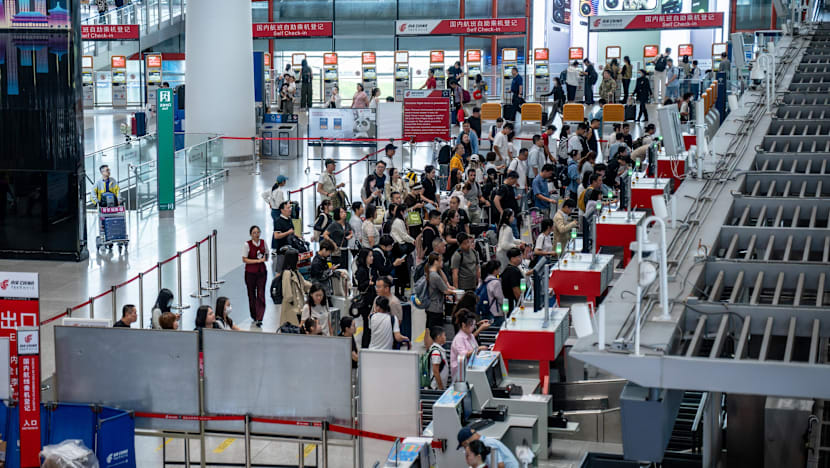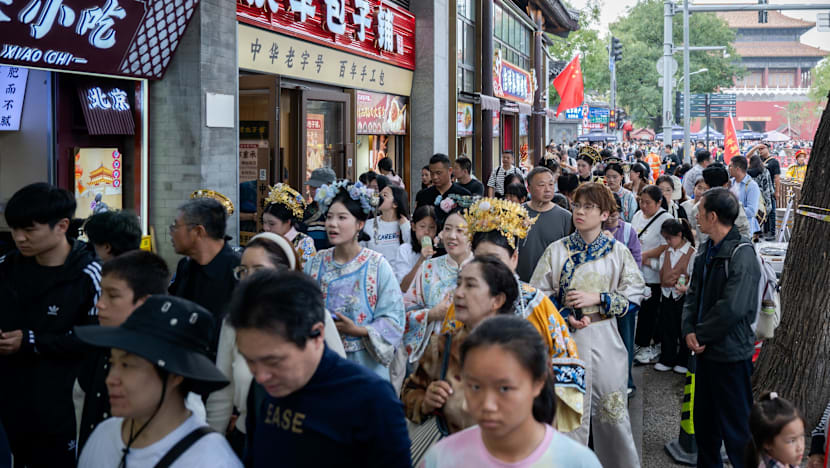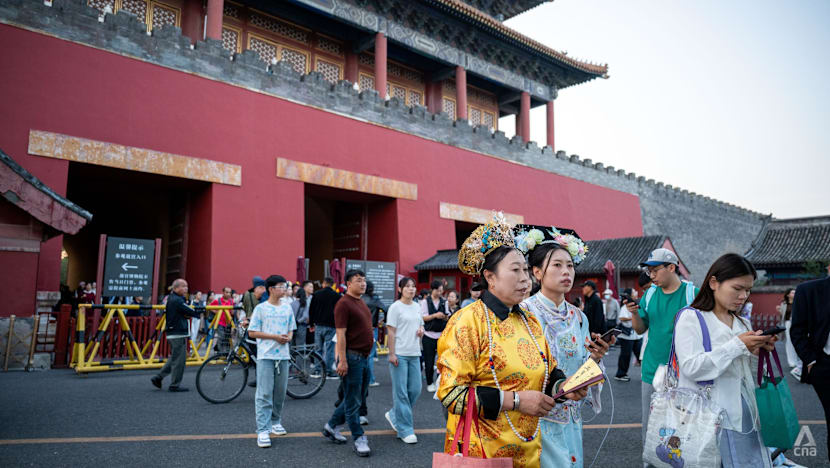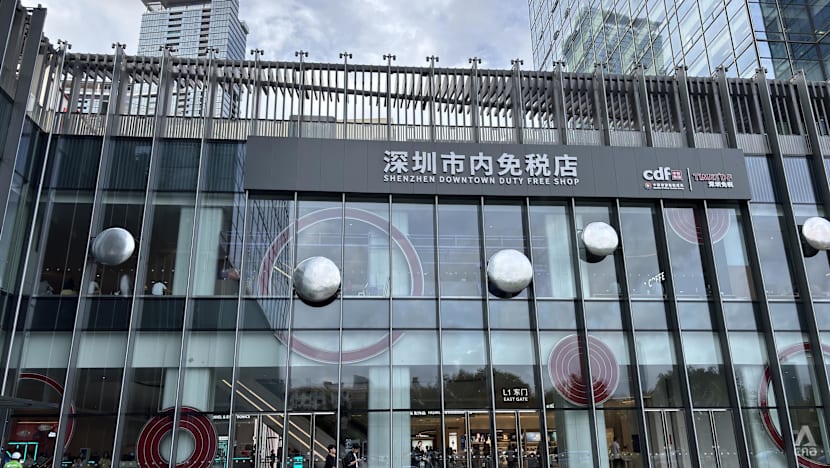Inbound tourism gathers pace as China’s ‘Super Golden Week’ travel rush sets new records
Beyond the eight-day travel buzz, experts say China’s inbound tourism is “rebounding strongly”, but it may require a different playbook to sustain momentum.

Passengers at Beijing Capital International Airport in China's capital city on Oct 1, 2025, as the “Golden Week” National Day holidays kicked off. (Photo: CNA/Hu Chushi)

This audio is generated by an AI tool.
SHENZHEN/SINGAPORE: Record passenger trips and an uptick in domestic tourism spending - China’s annual “Golden Week” holiday rush returned with a vengeance this year.
Figures from China’s Ministry of Transport and Ministry of Culture and Tourism revealed new holiday highs, with 888 million domestic tourist trips and 809 billion yuan (US$113.5 billion) in domestic tourism spending recorded nationwide between Oct 1 and 8 - both up more than 15 per cent year on year.
During the eight-day holiday, cross-regional passenger trips hit 2.43 billion - a record high, state news agency Xinhua reported.
Dubbed “Super Golden Week”, this year’s holiday combined two major holidays - national day and the Mid-Autumn Festival - extending the break to eight days instead of the usual seven.
And it wasn’t just Chinese holidaymakers making their mark.
Inbound tourism witnessed significant growth, with large numbers of travellers from countries like South Korea, Japan, Russia, Australia, Malaysia and also the United States - “fuelled by visa facilitation policies and a rich array of cultural and tourism activities”, according to Chinese state media reports.
This year’s “Super Golden Week” holiday also overlapped with other long holidays in the region like Japan’s Silver Week, which lasted from Sep 13 to 23, and the Chuseok holiday in South Korea, which ran from Oct 3 to 9.
Industry experts told CNA that this rare alignment created a perfect travel window for tourists visiting China - with many Japanese and South Korean travellers visiting during their breaks. Shanghai, Beijing and Hong Kong were popular destinations, said online travel agency Trip.com Group.


Notably, Beijing hosted 119,000 overseas arrivals during the holiday, an increase of 48 per cent compared to the same period last year. Their spending totalled 1.23 billion yuan, up 54.1 per cent year on year.
Popular destinations included Universal Studios Beijing, the Palace Museum housed in Forbidden City and districts like Sanlitun and Wangfujing for entertainment and shopping.
“Travelling to China has become very convenient under the visa-free policy,” Russian traveller Anna Ivanova told Xinhua upon her arrival in the city earlier this week.
“It only took me about 20 minutes from getting off the plane to clearing immigration,” she said.
H World Group, which operates more than 12,000 hotels nationwide, reported a 74.6 per cent year-on-year increase in foreign guest stays at its mainland China properties between Oct 1 and 8.
Beyond the “Golden Week” travel rush, signs are emerging of a broader rebound in China’s inbound tourism.
In the first eight months of 2025 alone, the National Immigration Agency (NIA) recorded 51.3 million foreign entries, a year-on-year increase of 27.8 per cent. Of these, 62.1 per cent were visa-free arrivals.
“More foreigners are visiting China for business and tourism purposes, as well as to work, study and live,” NIA said in a statement on Sep 18.
China has expanded visa-free access to 75 countries and counting, and rolled out a slew of measures to make travel more convenient, including simplified payment systems and instant tax refunds for departing visitors.
From Seoul to Singapore: New wave of global travellers
CNA also spoke to tourists from Singapore and Malaysia, who recently visited China.
Singaporean entrepreneur Ben Lee arrived in Xiamen city on China’s southeastern coast on Oct 5 - where he will spend a month exploring potential partnerships in AI education while also taking time for leisure activities like personal fitness training.
Travel costs were a big factor, Lee told CNA. He managed to book a hotel room, costing around S$11 a night. “Prices here are much lower, and with platform promotions, I’m actually spending less than I would back home,” Lee said.
This is his second trip to China.
His first visit was in 2023, right after pandemic-era measures had been lifted. He also recalled having to queue for half a day at a visa processing centre. “This time, it’s much more convenient with visa-free entry,” Lee said.
Recent visa-free travel arrangements between China and Malaysia also convinced Malaysian tourist Peiqi to visit Nanjing and Qingdao in June.
Chinese toys, brands and beverages have become very influential in recent years, the 25-year-old said. Using Chinese-made apps and platforms like Xiaohongshu also greatly shaped her decision to visit China this year.
She was especially keen on trying local food. “China has so many unique snacks and special dishes that we don’t (get in Malaysia),” she said.
NEW TOURISM PLAYBOOK
China’s inbound tourism is “rebounding strongly” and is emerging as a “significant driver” of the country’s economic recovery - directly benefiting sectors like hospitality, retail and transportation, supporting employment and contributing to immediate economic gains, said Robert Li Xiang, a professor at the Chinese University of Hong Kong (CUHK) and director of its hotel and tourism school.
“To sustain this growth, China is focusing on integrating culture and tourism while enhancing service standards. The Chinese tourism sector is also leveraging rapidly advancing technology to create new applications and experiences,” Li told CNA.
“Visa-free and transit visa exemptions now cover more countries, border procedures have been simplified, and tax-refund policies have been upgraded, making shopping and luxury experiences more attractive,” he said, adding that international flights and domestic transport links were also resuming steadily, with “digital tools, multilingual platforms and enhanced digital payment systems making travel more convenient”.
“This recovery is also driven by China’s overall improved service quality and increasing focus on tourist experience. Several high-profile social media influencers’ visits to China also helped,” Li said.
Traveller experiences are also greatly evolving, experts said - with more foreign tourists venturing beyond the usual big cities like Beijing and Shanghai - spending more and engaging in richer travel experiences.
“It’s not just about visitor numbers anymore,” said Shen Han, a professor of tourism management at Fudan University in Shanghai, who also noted that incentives like instant tax refunds for tourists had significantly boosted spending.
Foreign travellers visiting cities like Shenzhen and Guangzhou are now able to enjoy immediate tax refunds after making purchases at designated stores at locations like Shenzhen Bay and Bao’an International Airport.

“We are seeing more foreign travellers coming (to China) for leisure and cultural experiences, the kind of trips that encourage repeat visits and word-of-mouth growth,” Shen told CNA.
Growth will primarily stem from countries in Asia as well as Europe, Shen added.
“MORE THAN A POST-PANDEMIC BOUNCE”
The steady return of foreign tourists will not only help China recover from its pandemic lull, it also reflects “structural reforms, policy support, and evolving market dynamics”, said CUHK’s Li.
“While initial recovery in 2023 and early 2024 was fuelled by pent-up demand, more recent gains are underpinned by concrete measures such as visa facilitation, tax-refund reforms, infrastructure upgrades, service enhancements, and targeted promotion of both major urban centres and cultural or ecological destinations,” said Li.
“The ongoing expansion of inbound tourism signals not just a temporary recovery but a structural strengthening of China’s long-term tourism potential.”
But structural challenges continue to affect certain regions, he added.
Technological and digital barriers, such as local reservation systems requiring Chinese national IDs with limited multilingual support, could complicate trips for tourists outside major cities.
“Geopolitical tensions and safety perceptions also moderate demand from selected markets,” he said.
Peter Semone, chairman of the Pacific Asia Travel Association (PATA), believes that China’s tourism sector is “about to undergo an inbound boom”.
“This is much more than simply a post-pandemic bounce,” Semone told CNA, adding that inbound tourism is crucial for China's economic revival, although it remains “largely untapped” compared to domestic tourism.
“The outlook is positive, with a clear trajectory of growth,” he said. “There's never been a better time for Chinese tourism - the country is committed to strengthening its marketing approach (and) there is also a strong positive outlook for tourism from Southeast Asia, fuelled by political and economic ties and the large Chinese diaspora,” Semone said.
But the country needs to up its game, balancing domestic, outbound and inbound tourism growth. Issues like safety concerns, complex travel logistics and a lack of information in foreign languages “do hinder the market’s growth”, Semone said.
“While China has a vast array of assets, from stunning natural sites to a rich cultural heritage, it needs to better package (and sell) these offerings.”
“I also believe there needs to be a shift of focus from ancient Chinese civilisation as the core attraction to experiential tourism that also indulges contemporary Chinese culture,” he added.



















